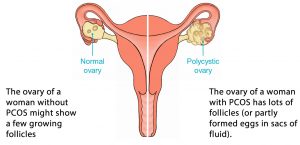Abdominal and Ovarian Pain in Women

Abdominal and ovarian pain are some of the top complaints in women. There are many things that can be causing the abdominal or ovarian pain. Some issues might be serious, and others might be minor and fleeting. Sometimes, what seems like abdominal pain can actually be caused by something in the ovaries, which sit below the abdomen. The only way to know for sure is to see a doctor and get to the source of the problem.
Here’s a look at some of the top causes of abdominal and ovarian pain:
Ovarian Cysts
Ovarian cysts are small, fluid-filled sacs that can form inside the ovaries. Some can be very small, and others can grow to the size of grapes or golf balls. You have probably had ovarian cysts yourself and didn’t realize it because most dissolve on their own. The cysts are caused by egg sacs that are not released or dissolved after ovulation.
If the cyst does not go away on its own and you experience significant pain, surgery can be performed to remove the cyst. However, in most cases, a doctor will only prescribe pain medication to treat the symptoms while waiting for the cyst to resolve itself on its own.
Polycystic Ovarian Syndrome (PCOS)
Polycystic ovarian syndrome, or PCOS, includes the presence of numerous cysts in the ovaries – up to 10 or more. But this condition is not JUST about having a lot of ovarian cysts. It also involves a hormonal imbalance, irregular periods, abnormal hair growth (such as on the face), and weight gain. Many women who have PCOS also struggle with fertility.
PCOS does not have a “cure.” It can be treated with synthetic hormones, the use of certain types of birth control, and some medications. Doctors also recommend that women suffering from PCOS make lifestyle changes, such as increasing exercise and reducing sugar and other negative diet influences.
Pelvic Inflammatory Disease
Pelvic inflammatory disease, or PID, is an infection in the uterus, ovaries, and/or fallopian tubes. Typically, the infection is caused by a sexually transmitted disease like gonorrhea or chlamydia. PID is very common, and it is usually the cause of pelvic pain in women.
Symptoms of PID can include pain, fever, diarrhea, vomiting, and vaginal discharge that has an odor. You may also experience fatigue or difficulty urinating. Because PID is caused by an infection, it is treated with antibiotics.
Food Poisoning
Abdominal pain can be caused by simple food poisoning. You eat something that was past its sell-by date or that was contaminated with something like salmonella or E. coli. Bacteria, viruses, and parasites can all be behind food poisoning, which most often leads to vomiting and diarrhea, as well.
Typically, there’s nothing you can do about food poisoning except wait for it to pass. You’ll get most of what’s causing you discomfort out of your body through the vomiting and diarrhea.
Irritable Bowel Syndrome
Irritable bowel syndrome, or IBS, is sometimes known as a spastic colon or irritable colon and is usually diagnosed through colonoscopy procedure. Symptoms include alternating bouts of constipation and diarrhea, cramping, abdominal pain, and bloating. The cause of the condition is unknown. However, if it is left untreated, it can cause permanent intestinal damage in some cases.
There is no cure for IBS, but you can manage the symptoms through strict lifestyle management. That means eating smaller meals that include nutrient-dense foods, cutting out caffeine and fried foods, taking probiotics to encourage good gut health, and minimizing stress. Adhering to a healthy diet can help to improve digestive activity and reduce the symptoms of IBS, including the abdominal pain it can cause.
Unfortunately, there is not always a solution for abdominal or ovarian pain. Sometimes, the best you can hope for is pain relief from the right medication. Everyone experiences these conditions differently, which means that everyone responds to the options for symptom management differently. Don’t suffer in silence. See your doctor and start making changes to find relief from your chronic pain.






